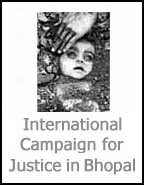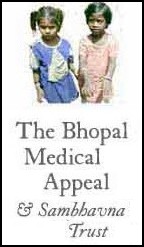This page isn’t intended to be a definitive repository for Bhopal-related information; that’s what books are for. But this page does helpfully categorize information resources by subject, and the casual researcher should be able to find everything they need here. For specific inquiries, please contact Ryan. ..........• Students
for Bhopal: A beautiful trifold flyer about SfB - it's best
to set your printer options to duplex short-edge flip before printing
(doc) ..........• Read our latest generic
Bhopal factsheet in 2-page
or 3-page format!
(pdf) ..........• Clouds
of Injustice (2004) by Amnesty International ..........• The Sambhavna
Clinic. Sambhavna provides free medical care to thousands of
gas victims, and their website is a wealth of medical information. ..........• An electronic
tour of the contamination in Bhopal. ..........• Background:
this site provides an overview and links to many of the relevant
documents. ..........• Dow
summons: Jan. 6, 2005 order issued by the Chief Judicial Magistrate's
court in Bhopal. Demands that Dow present itself to explain why
it continues to harbor its subsidiary, Union Carbide, from trial
before the court (pdf) ..........• Final
judgment of the Permanent Peoples' Tribunal on Industrial Hazards
and Human Rights, held in London from November 28 - December 2nd,
1994, to mark the tenth anniversary of the Bhopal disaster (pdf)
..........• Poison
papers: Union Carbide documentation, obtained through discovery
– an analysis. ..........• Bhopal.con:
Carbide’s Bhopal spin site dismantled. ..........• This
site contains many of the documents relating the shareholder
actions against Dow. ..........• Long
Walk to Delhi: read about the 360 mile march that 100 women
gas survivors undertook in 1989 to petition the Prime Minister.
..........• Compensation Community Survey (2002). Survey of Compensation among residents of Jaiprakash Nagar (pdf) ..........• US Congress. Letter to Dow signed by 18 members. Dated July 18, 2003. Members write: “More disturbing is the manner in which Union Carbide and Dow Chemical have ignored the summons of the Bhopal court. This exposes a blatant disregard for the law.” ..........• US Congress. Letter to Indian Prime Minister Singh signed by 20 members. Dated March 23, 2006. Members write: “After all this time, it is difficult to understand why so few steps have been taken to alleviate the suffering of the Bhopal survivors. The Indian Government has repeatedly said that justice will be served, but has exemplified no commitment to this end. At a time when a new generation of victims is surfacing among children born to gas-affected parents and those exposed to contaminated drinking water, the Government must take care of those affected by this horriffic tragedy. In addition, they must hold Union Carbide and its parent company Dow Chemical responsible for the disaster." ..........• US Congress. Resolution proposed September 29, 2004. The resolution calls upon Dow to completely restore the polluted plant site to a habitable condition, fully remedy the drinking water supply, and produce Union Carbide to face criminal trial in the Bhopal court. So far co-sponsors of the resolution, which was referred to the House Committee on International Relations, include: Sherrod Brown (D-OH), Karen McCarthy (D-MO), Ed Towns (D-NY), Jim McDermott (D-WA), Nick Lampson (D-TX), Anna Eshoo (D-CA), Michael McNulty (D-NY), Joe Crowley (D-NY), and Jan Schakowsky (D-IL). Read the text here (pdf) ..........• European Union Parliament. Resolution passed December 17, 2004. Read the text here. ..........• European Union Parliament. Resolution passed October, 2005. The resolution notes that twenty years after the Union Carbide disaster in Bhopal, the site has still not been cleaned up and calls on the Indian authorities and on Dow Chemicals to clean up the toxic waste immediately. Read the text here. ..........• European Union Parliament. Resolution proposed, 1999. ..........• UK House of Commons. Early Day Motion, proposed March 24th, 2003. Supported by 61 MPs.
..........• City of San Francisco. Resolution passed April 15, 2004. Read the text here. ..........• City of Seattle. Proclamation passed Nov. 28, 2005. ..........• City of Boston. Letter signed by three members of the City Council. Dated May 12, 2004. ..........• University of Michigan student government. Resolution passed March 17, 2003. A copy of the letter that the Michigan Student Assembly's Environmental Issues Commission sent to the President and Regents of the University of Michigan, as called for by its Bhopal resolution ..........• University of California, Berkeley student government. Resolution passed December 8, 2004. ..........• University of Texas, Austin student government. Resolution passed February 14, 2006. ..........• University of Texas, Austin graduate student assembly. Resolution passed February 21, 2006. ..........• Wheaton College student government. Resolution passed April 24, 2003. ..........• NRI letter to Prime Minister Manmohan Singh in support of the March to Delhi and its demands. Signed by more than 30 NRI organizations and nearly 50 organizations in total. ..........• Faculty Petition for Justice in Bhopal. Signed by more than 400 academics, worldwide. Animal's People Many of you have read Indra's pieces on bhopal.net, the 777 newsletters and scores of campaign material he has produced in the last fourteen years. imagine all of that anger, sadness, laughter, bawdiness, absurdity and flights of power defying imagination in one book - thats Animal's People. It is an intimately gripping story told by 'Animal' a young survivor of the 'apokalis' [apocalypse] in the city of Khaufpur. Everybody calls him Animal because he lopes on his feet and hands due to his bent spine - damage caused by the gases of the apokalis. He lies, cheats, peeps at bathing women, thinks unprintable thoughts, dreams wet dreams, verges on betraying the cause for justice but throughout remains starkly real and immensely lovable. The people around Animal are fellow survivors, activists, American do gooders, musicians, government officials, lumpens and lust objects. Together it is the story of the have-nothings fighting the have-alls and winning. Khaufpur is as close or far from Bhopal as you want it to be but I am sure you will enjoy the retelling of the many campaigns that all of you have been part of and recognise the intricacies of wickedness and resistance in a gassed city. For sure it has the power to make a whole new set of people curious and potentially sympathetic to the ongoing struggle of Bhopal. The book is published in England and available on Amazon UK . Please forward this and encourage friends to buy this brilliant book. You can read extracts at www.indrasinha.com, and each copy ordered from Amazon UK via Indra's website earns 60 pence (€1 / US $1.20) for the Bhopal Medical Appeal. The Bhopal Reader This new book on the notorious Bhopal gas leak shows why this industrial disaster has become a permanent symbol of corporate irresponsibility and technological abandon for the citizens of our planet. The tragedy unleashed by an American multinational corporation (Union Carbide) killed more than 15,000 people on the night of December 3, 1984 in the densely populated Indian city of Bhopal. A valuable reference text for industrial accidents and corporate crimes as well as a handbook for research, prevention and activism, the collection includes gripping first person stories of some of the 200,000 permanently-injured survivors, activists, journalists, scientists, doctors, government and corporate officials. This anthology brings together never-before published testimonies, archival documents translated from Hindi, legal and scientific evidence and commentary, social analysis, and corporate perspectives on liability, with comprehensive introductions for each aspect of the disaster. This chronicle of a 21-year campaign against two of the world’s most powerful chemical corporations, Union Carbide and Dow Chemical Co. (which now owns Union Carbide), parallels the emergence of public understanding of environmental safety and corporate accountability that Bhopal helped to create. In 1984, the deadly pesticide used in Bhopal and in the United States was hailed by agro business as part of its “green revolution.” The Bhopal Reader documents forces that are even now bringing Bhopali women to the very doors of the corporation in protest. Some 21 years later, the drinking water is contaminated because Union Carbide never cleaned up its abandoned factory with bags of stored chemicals, causing genetic damage to yet another generation from the deadly methyl isocyanate (MIC) gas. The book reports on the international Bhopal campaign being waged today by survivors, activists, lawyers, doctors —in India, the U.S., Britain and elsewhere around the world—for compensation for all the Bhopal victims. It takes its readers across continents, into newspapers, television stations, websites, courtrooms, shareholders annual meetings, campuses, and chemical plants. The Bhopal Reader presents a valuable case study of the complexities of fighting for justice in a world increasingly overrun by the politics of corporate rule under globalization. Its voices herald the dialogues that will dominate this new century and The Bhopal Reader is the indispensable guide to understanding them. Edited by Bridget Hanna, Ward Morehouse, and Satinath Sarangi. 2005, 307 pages. Read a review by SocialFunds.com. The Bhopal Gas Tragedy Though the book was intended for young people, there has been a lot of interest from different kinds of organisations including colleges and others. This detailed but accessible style of information has had a wide appeal among people concerned about the issues involved. “The connections and pathways to death and destruction are, indeed, intricate. So attempting to explain a complex issue like the Bhopal gas tragedy to teenagers is a truly daunting task. Suroopa covers a lot of ground in this slim volume, detailing most of the relevant issues and questions this 'alarm call for mankind' confronts human society with. These include the role of transnationals in a globalising economy, in particular corporate responsibility in a developing country; the technological impact of industrialisation, with a focus on the nature of technology used and its implications for safety; the medical impact of an industrial disaster; the legal aspect of liability and culpability of corporate bodies for accidents occurring in their plants; and the role of the government, its relationship to the corporate sector and its response to the medical, compensation and rehabilitation issues.” Read the rest of the review here. By Suroopa Mukherjee. 2002, 48 pages. Bhopal: The Inside Story In addition, personal testimonies and other eyewitness accounts from fifteen other workers disclose horrendous situations and practices in the factory, demolishing the carefully-nurtured myth that multinationals like Union Carbide always use "world-class" technology wherever they set up shop. By T.R. Chouhan, with contributions by Claude Alvares, Indira Jaising and Nityanand Jayaraman. 2004, 195 pages. Updated second edition. The Bhopal Saga: Causes and Consequences of the World's
Largest Industrial Disaster The Bhopal Saga is an incisive analysis of the world’s worst industrial accident. This book contains a thorough review of most of what has been written about the incident since 1984. It discusses the conflicting stance of the Union Carbide Corporation and the Governments of India on the moral responsibility for the tragedy. Eckerman’s analysis demonstrates that the two most important factors leading to the mega-gas leak were the design of the plant and the company policy of cutting back on expenses. The same analysis shows that negligence by the company and the authorities have critically affected the impact of the leakage on people’s lives. By Dr. Ingrid Eckerman. 2005, 304 pages. Five Past Midnight in Bhopal Half of all royalties for this book go to the Dominique Lapierre City of Joy Indian Foundation to support humanitarian actions in Bhopal. By Dominique Lapierre and Javier Moro. 2002, 401 pages. Read this excellent review! Trespass Against Us: Dow Chemical and the Toxic Century The Dow Chemical Company has been trespassing on private property for decades and getting away with it. The trespass in this case is harmful and it is toxic. For the transgressors at issue are man-made synthetic chemicals, more than 100,000 of which have been "invented" and let loose in the world since the 1930s. Yet many of these chemicals are toxic to life and have been doing harm for years, insinuating themselves into blood, body tissue, sperm and egg. "Body burdens" of toxic chemicals are now being measured in humans and wildlife all over the globe. The result is not a pretty picture: cancers, birth defects, poisoned workers, and polluted communities. The guilty parties in these transgressions, however, have not been brought to account, and they have not been stopped. To this day, "toxic trespass" continues, and it is poisoning all of us.
Trespass Against Us, the groundbreaking new book by investigative writer Jack Doyle, details dozens of cases in which poisonous chemical products and by-products produced by Dow Chemical Company have silently invaded the human body. According to Doyle, this constitutes a grave and unrecognized “toxic trespass” that should be prosecuted as any other type of infringement on property rights. “Personal and public health, human blood and body tissue, reproduction and developmental biology – these are the highest, most personal, most sacrosanct forms of property,” argues Doyle. “Yet chemical companies like Dow are regularly violating – trespassing – on human health and well being.” By Jack Doyle. 2004, 512 pages. More information is available at the Trespass Against Us website. An Unreasonable Woman: A True Story of Shrimpers, Politicos,
Polluters, and the Fight for Seadrift, Texas Diane Wilson, fourth-generation shrimp-boat captain and mother of five, proves that one “ordinary” woman can force a giant chemical company to change its ways. When Wilson learns that she lives in the most polluted county in the United States, she launches a campaign against a multi-billion-dollar corporation that has been covering up spills, silencing workers, flouting the EPA, and dumping lethal ethylene dichloride and vinyl chloride into the bays along her beloved Texas Gulf Coast.
An Unreasonable Woman is a page-turner to rival stories like Erin Brockovich, Silkwood, and The China Syndrome. By Diane Wilson. 2005, 400 pages. More information is available at the An Unreasonable Woman website. The Bhopal Tragedy: What Really Happened and What it Means
for American Workers and Communities at Risk By Ward Morehouse and M. Arun Subramaniam. 1986, 190 pages. Deceit and Denial: The Deadly Politics of Industrial Pollution Deceit and Denial is unusual in a number of respects, including the fact that much of it is based on documents historians rarely if ever use in critical evaluations of corporate behavior. These documents include internal company correspondence, memos and minutes of meetings of both the lead and chemical industry trade associations and some of their member companies. The extensive cache of documents used for the book had become available through legal proceedings in cases involving injured children, consumers and workers. By Gerald Markowitz and David Rosner. 2002, 464 pages. Read more at the Deceit and Denial website. Advocacy after Bhopal: Environmentalism, Disaster, New
Global Orders Kim Fortun explores these claims by focusing on the dynamics and paradoxes of advocacy in competing power domains. She moves from hospitals in India to meetings with lawyers, corporate executives, and environmental justice activists in the United States to show how the disaster and its effects remain with us. Spiraling outward from the victims' stories, the innovative narrative sheds light on the way advocacy works within a complex global system, calling into question conventional notions of responsibility and ethical conduct. Revealing the hopes and frustrations of advocacy, this moving work also counters the tendency to think of Bhopal as an isolated incident that "can't happen here." By Kim Fortun. 2001, 488 pages. ..........• Bhopal,
Sitting at the Edge of a Volcano... (1982) by Rajkumar Keswani,
warning of disaster.
|
The international student campaign to hold Dow
accountable for Bhopal, and its other toxic legacies around the world.
For more information about the campaign, or for problems regarding this
website, contact Ryan
Bodanyi, the Coordinator of Students for Bhopal.
WE
ALL LIVE  IN
BHOPAL
IN
BHOPAL
"The year 2003 was a special year in the history of the campaign for justice in Bhopal. It was the year when student and youth supporters from at least 30 campuses in the US and India took action against Dow Chemical or in support of the demands of the Bhopal survivors. As we enter the 20th year of the unfolding Bhopal disaster, we can, with your support, convey to Dow Chemical that the fight for justice in Bhopal is getting stronger and will continue till justice is done. We look forward to your continued support and good wishes, and hope that our joint struggle will pave the way for a just world free of the abuse of corporate power."
Signed/ Rasheeda Bi, Champa Devi Shukla
Bhopal Gas Affected Women Stationery Employees Union
International Campaign for Justice in Bhopal
This is what the www.studentsforbhopal.org site looked like in early 2008. For more recent information, please visit www.bhopal.net.















